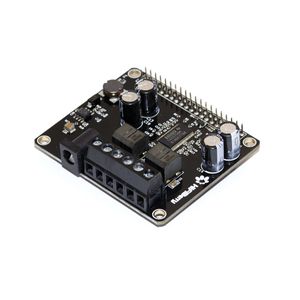HiFiBerry Amp2
| HiFiBerry Amp2 | |
|---|---|

| |
| Modality | Audio |
| Part Type | Raspberry Pi HAT |
| Manufacturer | HiFiBerry |
| Product ID/Part Number | Amp2 |
| Product Page | https://www.hifiberry.com/shop/boards/hifiberry-amp2/ |
| Datasheet | File:Https://www.hifiberry.com/docs/data-sheets/datasheet-amp2/ |
| Price (USD) | 49.90 |
| HiFiBerry Amp2 | |
|---|---|
| Uses Interface(s) | I2C |
| HiFiBerry Amp2 | |
|---|---|
| Uses (Board-Numbered) GPIO Pin(s) | 3, 5, 12, 35, 38, 40, 7 |
| Provides Backpower | Yes |
| Computer Card Type | DAC |
The HiFiBerry Amp 2 is an integrated Amplifier and Sound Card HAT for the Raspberry Pi capable of playing audio at 24 bits/192kHz.
WARNING: while the part is rated up to 192kHz, there seems to be a low-pass filter applied to the amplifier, see here: https://support.hifiberry.com/hc/en-us/community/posts/360014295118-Ultrasonic-frequency-response?mobile_site=true
ICs
- Amplifier: Uses Part:TAS5756M
Configuration
Note that the following is encapsulated in the autopilot script hifiberry, which can be executed with
python -m autopilot.setup.run_script hifiberry
Device Tree
In /boot/config.txt, remove or comment out the following to disable the built-in audio[1]:
dtparam=audio=on
And add the line:
dtoverlay=hifiberry-dacplus
ALSA
Optionally, you can make the card the default sound-card for ALSA by creating a /etc/asound.conf file with the following
pcm.!default {
type hw card 0
}
ctl.!default {
type hw card 0
}
GPIO Usage
The following pins are reserved and can't be used for other purposes[2]:
| Board Pins | BCM # | Use |
|---|---|---|
| 3, 5 | 2, 3 | I2C Configuration |
| 12, 35, 38, 40 | 18-21 | Sound interface |
| 7 | 4 | Mute -- pulling low mutes (so pull it up!) |
Specs
Recommend powering with an 18V power supply!
| Recommended operating voltage | 12-20V | |
| Absolute maximum operating voltage | 24V | |
| Maximum output power | 60W | |
| THD+N | <0.02% | typical, output power 0.1-10W |
| SNR | 104db | typical |
| Frequency response | 20-20000Hz | output filter characteristics depending on specific speaker parameters |
| Typical output power per channel | 14W | Vsupply=12V, Rspk = 4Ohm, THD+N <0.1% |
| 18W | Vsupply=18V, Rspk = 4Ohm, THD+N <0.1% | |
| 20W | Vsupply=24V, Rspk = 4Ohm, THD+N <0.1% | |
| 8W | Vsupply=12V, Rspk = 8Ohm, THD+N <0.1% | |
| 17W | Vsupply=18V, Rspk = 8Ohm, THD+N <0.1% | |
| 28W | Vsupply=24V, Rspk = 8Ohm, THD+N <0.1% | |
| Maximum output power per channel | 15W | Vsupply=12V, Rspk = 4Ohm, THD+N <10% |
| 30W | Vsupply=18V, Rspk = 4Ohm, THD+N <10% | |
| 44W | Vsupply=24V, Rspk = 4Ohm, THD+N <10% | |
| 10W | Vsupply=12V, Rspk = 8Ohm, THD+N <10% | |
| 20W | Vsupply=18V, Rspk = 8Ohm, THD+N <10% | |
| 38W | Vsupply=24V, Rspk = 8Ohm, THD+N <10% | |
| Sample rates | 44.1-192kHz |